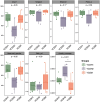The distribution characteristics of aerosol bacteria in different types of sheepfolds
- PMID: 38420208
- PMCID: PMC10900508
- DOI: 10.3389/fvets.2024.1348850
The distribution characteristics of aerosol bacteria in different types of sheepfolds
Abstract
With the development of modern sheep raising technology, the increasing density of animals in sheep house leads to the accumulation of microbial aerosols in sheep house. It is an important prerequisite to grasp the characteristics of bacteria in aerosols in sheep house to solve the problems of air pollution and disease prevention and control in sheep house. In this study, the microorganisms present in the air of sheep houses were investigated to gain insights into the structure of bacterial communities and the prevalence of pathogenic bacteria. Samples from six sheep pens in each of three sheep farms, totaling 18, were collected in August 2022 from Ningxia province, China. A high-volume air sampler was utilized for aerosol collection within the sheep housing followed by DNA extraction for 16S rRNA sequencing. Employing high-throughput 16S rRNA sequencing technology, we conducted an in-depth analysis of microbial populations in various sheep pen air samples, enabling us to assess the community composition and diversity. The results revealed a total of 11,207 operational taxonomic units (OTUs) within the bacterial population across the air samples, encompassing 152 phyla, 298 classes, 517 orders, 853 families, 910 genera, and 482 species. Alpha diversity and beta diversity analysis indicated that differences in species diversity, evenness and coverage between different samples. At the bacterial phylum level, the dominant bacterial groups are Firmicutes, Proteobacteria, and Actinobacteria, among which Firmicutes (97.90-98.43%) is the highest. At the bacterial genus level, bacillus, Bacteroides, Fusobacterium, etc. had higher abundance, with Bacillus (85.47-89.87%) being the highest. Through an in-depth analysis of microbial diversity and a meticulous examination of pathogenic bacteria with high abundance in diverse sheep house air samples, the study provided valuable insights into the microbial diversity, abundance, and distinctive features of prevalent pathogenic bacteria in sheep house air. These findings serve as a foundation for guiding effective disease prevention and control strategies within sheep farming environments.
Keywords: Miseq sequencing; microbial aerosols; microbial community structure and diversity; pathogenic bacteria; sheepfolds air.
Copyright © 2024 Wang, Yu, Raheem, Guo, Ma and Lu.
Conflict of interest statement
The authors declare that the research was conducted in the absence of any commercial or financial relationships that could be construed as a potential conflict of interest.
Figures






Similar articles
-
Spatial distribution of airborne bacterial communities in caged poultry houses.J Air Waste Manag Assoc. 2023 May;73(5):417-427. doi: 10.1080/10962247.2023.2193162. J Air Waste Manag Assoc. 2023. PMID: 36947580
-
The Distribution Characteristics of Aerosol Bacteria in Different Types of Pig Houses.Animals (Basel). 2022 Jun 14;12(12):1540. doi: 10.3390/ani12121540. Animals (Basel). 2022. PMID: 35739876 Free PMC article.
-
Temporal variation characteristics of microbial aerosols in the goose house environment.Br Poult Sci. 2024 Oct;65(5):538-545. doi: 10.1080/00071668.2024.2360621. Epub 2024 Jul 12. Br Poult Sci. 2024. PMID: 38995230
-
Effect of Different Disinfectants on Bacterial Aerosol Diversity in Poultry Houses.Front Microbiol. 2018 Sep 11;9:2113. doi: 10.3389/fmicb.2018.02113. eCollection 2018. Front Microbiol. 2018. PMID: 30271388 Free PMC article.
-
Effects of different laying periods on airborne bacterial diversity and antibiotic resistance genes in layer hen houses.Int J Hyg Environ Health. 2023 Jun;251:114173. doi: 10.1016/j.ijheh.2023.114173. Epub 2023 Apr 27. Int J Hyg Environ Health. 2023. PMID: 37119673
References
LinkOut - more resources
Full Text Sources

